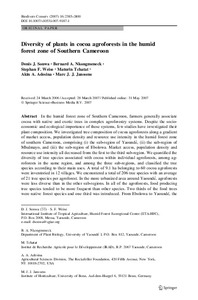| dc.contributor.author | Sonwa, D.J. |
| dc.contributor.author | Nkongmeneck, B.A. |
| dc.contributor.author | Weise, S.F. |
| dc.contributor.author | Tchatat, M. |
| dc.contributor.author | Adesina, A.A. |
| dc.contributor.author | Janssens, M.J.J. |
| dc.date.accessioned | 2019-12-04T11:14:13Z |
| dc.date.available | 2019-12-04T11:14:13Z |
| dc.date.issued | 2007-07 |
| dc.identifier.citation | Sonwa, D.J., Nkongmeneck, B.A., Weise, S.F., Tchatat, M., Adesina, A.A. & Janssens, M.J. (2007). Diversity of plants in cocoa agroforests in the humid forest zone of Southern Cameroon. Biodiversity and Conservation, 16(8), 2385-2400. |
| dc.identifier.issn | 0960-3115 |
| dc.identifier.uri | https://hdl.handle.net/20.500.12478/2693 |
| dc.description.abstract | In the humid forest zone of Southern Cameroon, farmers generally associate cocoa with native and exotic trees in complex agroforestry systems. Despite the socio-economic and ecological importance of these systems, few studies have investigated their plant composition. We investigated tree composition of cocoa agroforests along a gradient of market access, population density and resource use intensity in the humid forest zone of southern Cameroon, comprising (i) the sub-region of Yaoundé, (ii) the sub-region of Mbalmayo, and (iii) the sub-region of Ebolowa. Market access, population density and resource use intensity all decreased from the first to the third sub-region. We quantified the diversity of tree species associated with cocoa within individual agroforests, among agroforests in the same region, and among the three sub-regions, and classified the tree species according to their main uses. A total of 9.1 ha belonging to 60 cocoa agroforests were inventoried in 12 villages. We encountered a total of 206 tree species with an average of 21 tree species per agroforest. In the more urbanized area around Yaoundé, agroforests were less diverse than in the other sub-regions. In all of the agroforests, food producing tree species tended to be more frequent than other species. Two thirds of the food trees were native forest species and one third was introduced. From Ebolowa to Yaoundé, the density of food producing trees doubled and the density of exotic food-producing species increased relative to native species. Some local species producing high-value non-timber forest products were found in the agroforests, but their density was far lower than that of exotic tree species. The agroforests also provide medicine, charcoal and other products for household consumption and sale. We conclude that unless there are specific efforts to promote local forest tree species in cocoa agroforests, these will progressively lose importance with increasing market access, population pressure and land use intensity. |
| dc.description.sponsorship | German Academic Exchange Service |
| dc.description.sponsorship | Mars Inc. |
| dc.format.extent | 2385-2400 |
| dc.language.iso | en |
| dc.subject | Cocoa (Plant) |
| dc.subject | Agroforestry |
| dc.subject | Market Access |
| dc.subject | Plant |
| dc.subject | Humid Forest Zone |
| dc.title | Diversity of plants in cocoa agroforests in the humid forest zone of Southern Cameroon |
| dc.type | Journal Article |
| dc.description.version | Peer Review |
| cg.contributor.affiliation | International Institute of Tropical Agriculture |
| cg.contributor.affiliation | Université de Yaoundé |
| cg.contributor.affiliation | Institut de Recherche Agricole pour le Développement, Cameroon |
| cg.contributor.affiliation | The Rockefeller Foundation |
| cg.contributor.affiliation | University of Bonn |
| cg.coverage.region | Africa |
| cg.coverage.region | Central Africa |
| cg.coverage.country | Cameroon |
| cg.creator.identifier | Denis Sonwa: 0000-0001-6427-3428 |
| cg.creator.identifier | ADESOJI ADESINA: 0000-0001-9653-969X |
| cg.isijournal | ISI Journal |
| cg.authorship.types | CGIAR and developing country institute |
| cg.iitasubject | Cocoa |
| cg.iitasubject | Forestry |
| cg.journal | Animal Feed Science and Technology |
| cg.howpublished | Formally Published |
| cg.accessibilitystatus | Limited Access |
| local.dspaceid | 93616 |
| cg.targetaudience | Scientists |
| cg.identifier.doi | http://dx.doi.org/10.1007/s10531-007-9187-1 |

